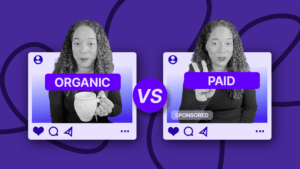Unlocking the Power of UGC Niches: How Different Industries Can Benefit from User-Generated Content
With over 7 years of e-commerce experience, Agne has mastered the balance of creativity and performance. From guiding social media strategies to crafting high-converting ads, she’s all about results.

Most business leaders understand the general marketing benefits of user-generated content (UGC).
But how does it apply to specific industries?
That’s what we discuss in this post. This article explores how various sectors can use it to their advantage, followed by some case studies of brands of using UGC niches to gain the best results for their campaigns.
Fashion and Beauty: UGC Niches Tailored for Visual Appeal
UGC plays naturally into the hands of fashion industry companies because it is so visual. Brands don’t have to do much more than tell creators to wear their clothing and post images online to gain exposure.
Around 96% of U.S. fashion brands use UGC in their marketing. Most appeal to the 25 million or so brand accounts on social media that interact with billions of prospective consumers worldwide.
Brands use UGC-related interactions in various ways. Some leverage them to build authenticity and trust. Clothing and beauty companies showcase their customers’ real-life experiences and how they use their products. Many provide authentic, honest reviews as a brand-building strategy.
Another reason is to gather customer insights. UGC helps companies learn more about how users perceive their products and what they need to do better. For many, it is a way to gain influencers and promote products in ways that make sense to the customers who will eventually use them.
Lastly, some brands use UGC for shoppable posts (a trend that’s gaining traction more recently). The idea is to include links that let consumers shop immediately instead of navigating to a third-party website. Curated content can generate reliable sales funnels that let brands communicate directly via social media channels to the community.
Finding creators like these is more straightforward on platforms like Billo. It simplifies identifying creators with relevant audiences and using them for UGC marketing. You can expand the available pool of suitable influencers faster without manually doing it.
The shape that fashion and beauty UGC takes depends on the platform. On YouTube, influencers focus on product comparisons or unboxing videos since that’s what their audiences expect. Fashion hauls take center stage on TikTok, while Instagram is more about outfits and makeup looks.
Case Study: River Island
River Island has one of the most intelligent UGC campaigns in the fashion and beauty sector. The company understands how to appeal to its audience and get them interested in what it does using this approach.
Its primary tool is social commerce, a new way to sell online. The idea is to combine social media with the shopping experience to make it more engaging and interactive. Influencers and creators share images of themselves wearing outfits online with links to product pages on River Island’s website or native shopping portals on the social media channel.
This approach to shopping is fun because the content constantly changes. New UGC creators showcase their ideas, helping to drive novelty and interest, updating their profiles every few days with additional concepts. Users see River Island’s clothing in a new light whenever they log in.
Travel and Hospitality: UGC Niches Leveraging Customer Experiences
UGC is also making waves in the travel and hospitality sectors. Creators are providing prospective clients with a more authentic understanding of what future experiences with them will be like.
Part of the role of UGC niches creators is to inspire travel decisions. Showing them photos and videos of what specific destinations are like builds on the industry’s traditional visual approach. Many offer valuable information that simply isn’t available through regular corporate marketing. Furthermore, this method enhances the online presence of many experiences that would be harder to find. UGC brings them to the fore on social media, increasing engagement and encouraging consumers to explore their services further. Agencies offering rare destinations can reach a broader audience.
There’s also an element of customer feedback involved. UGC makes it more straightforward for firms in the industry to address their audience’s concerns if the same problems arise repeatedly.
For example, travel companies sometimes receive negative reviews with little explanation. If customers outline the problem – say, the food – the brand can resolve this quickly and start to make headway.
Travel and hospitality UGC varies according to platform, just as it does in the fashion and beauty sector. Instagram is a hotspot for travelers sharing photos of their adventures, while TikTok focuses more on recommendations. Creators will often run through where they think people should go on vacation or for a fabulous meal.
TripAdvisor is another common option for UGC because of the review element. Creators use it to give their honest opinions of specific restaurants or places to visit in given regions, providing granular details about who should attend these attractions and why.
Lastly, Google Reviews and Maps are essential forums for travel and hospitality UGC. Often, the first content they encounter about their services comes in these critical areas.
Cajoling creators and audiences into creating compelling and favorable reviews can be challenging. But with UGC management apps, like Billo, working with pools of talented individuals is simple. Most are willing to take on jobs if it means getting paid while providing an authentic take on your business.
Case Study: Airbnb
Airbnb is arguably the master of leveraging UGC to push its business. It uses it everywhere to get people interested in its services.
For example, the room-sharing app uses UGC to interact with its customers based on Facebook, Instagram, and Twitter. The brand leverages #Airbnb on travel-related listings to target customer growth through experiences and competitions. User-generated stories and images help the company by showing more of what it does, revealing what it is like to live in its accommodation without using corporate gloss. All it has to do is find willing creators to capture short pieces of content or rooms and places, especially those that are part of unique stays.
Airbnb encourages guests to say what they think about accommodation. This authenticity builds trust and encourages more people to use the site versus conventional hotels.
Tech and Gadgets: UGC Niches for Product Reviews and Demos
UGC has also become a part of the tech and gadget industry’s approach to digital marketing. Thousands of creators now review its products and introduce them to their audiences.
Tech UGC is effective because of the hype the industry can generate. Unlike other niches, tech is always evolving and companies are developing new ideas as the underlying processes improve. Secular trends, like miniaturization and Moore’s Law, are making new things possible every year.
Part of the benefit of tech UGC is the drive toward authentic product reviews. User-generated content shows what it is like to use products daily, providing a more accurate representation and understanding. Commentators offer diverse perspectives, allowing consumers to build a more rounded view of products’ relative strengths and weaknesses.
The social proof of UGC is also a critical element (particularly for brands that aren’t Apple or Google). Creators providing positive feedback helps to build trust and enable smaller firms to gain traction in an otherwise fiercely competitive industry.
When this individual is less of a known influencer and more of a peer this aspect is more profound. An individual who comes across as being an amateur or something just looking to review products for fun is more likely to garner the attention of individuals looking for honest and genuine opinions.
With that said, conventional influencer marketing can also be effective. Endorsements by creators with millions of followers can impact sales and conversions noticeably in the tech industry, causing more people to consider purchasing products. The more authentic audiences perceive a recommendation to be, the more impactful it becomes.
YouTube is helpful for UGC content because of its long-form focus. Many creators leverage it for unboxing views and reviews. These can go into exquisite detail, going into depth about what specific products offer and how they benefit users. Tech UGC is useful for product demonstrations and tutorials on this platform. Influencers use their expertise to explain how to use devices and put them in the context of what’s come before. Often, UGC bypasses the formalities of conventional advertising and shows products being used in real-world-like situations.
TikTok isn’t as comprehensive as YouTube because of the shorter video segments. However, the platform is ideal for setting challenges or unique ways to enjoy new devices that even the manufacturer didn’t consider.
Lastly, you often see tech UGC on forums like Reddit. These can be more technical and provide professional UGC creators with ways to demonstrate their talents.
Case Study: GoPro
Before its UGC marketing initiatives, few had heard of GoPro. The outdoor adventure camera maker was a niche company with a small market of mainly kayaking and cycling enthusiasts.
However, everything changed once it started its legendary UGC campaign. Its stock price soared and, for a while, the brand became one of the hottest tech stocks.
GoPro wasn’t timid in its approach to UGC. Instead, it offered creators a chance to share a portion of a $1 million prize fund to produce the best videos they could using its products.
Because first-person shots of adventure experiences were rare at the time, the UGC-driven marketing caused the firm to take off. It received over 25,000 submissions from people using its camera technology, giving the brand’s marketing team ample material to curate and push out onto its social channels.
GoPro later adopted a “UGC-first” strategy. It saw that this form of marketing was more effective than any other, allowing the firm to advertise covertly to prospects using more engaging and authentic channels.
Health and Wellness: UGC Niches in a Growing Market
Finally, the health and wellness segment can benefit from UGC in a growing market. User-generated content bridges the gap between brands and their consumers, building trust and driving sales.
UGC is effective in this space because it builds communities. Many creators and audiences want to work toward their wellness goals together. Influencers often offer support and motivation for these journeys, making them more achievable, and encouraging product use.
For example, user-generated content plays a critical role in education. Niche UGC can dispel health myths, avoid misconceptions, and share healthy, evidence-based advice with confused audiences.
It can also provide sound advice based on science. Influencers show their audiences what they should do to achieve maximum results.
To be on the safe side, many health and wellness organizations partner with respected and trusted creators. These individuals make authentic recommendations in line with their beliefs, not just because they get paid.
You can find health and wellness UGC across numerous platforms. The most common venue is website blogs and vlogs. These provide influencers with the space they need to get their message across in detail.
Instagram is also a good health and wellness platform for recipes and fitness routines. Condensing all the information into a single image makes it more digestible for audiences who want to learn how to take care of themselves faster.
Finally, TikTok is becoming a health and wellness resource. Short-form videos often cover common health challenges and how to overcome them (often with the assistance of a product).
Case Study: Peloton
Peloton is an excellent example of a company in the health and wellness niche that successfully used UGC to build its brand. The firm used its user base to sell its concept and succeed in a relatively new industry.
The company began by asking users to upload their workouts onto the cloud where it added them to its vast database. Other members could then follow along, creating a proto-community, similar to Strava.
Soon after, a library of content became available. Users could use this for inspiration or ideas for how to get the most from their equipment.
To increase engagement further, Peloton began setting community challenges. These encouraged users to share their progress with others, working toward specific times. Social media integration meant that they could inspire their peers to get on their static bikes, making exercise more psychologically compelling.
Looking to find creators for different UGC niches?
Creative Manager
With over 7 years of e-commerce experience, Agne has mastered the balance of creativity and performance. From guiding social media strategies to crafting high-converting ads, she’s all about results.

Authentic creator videos, powered by real performance data
22,000+ brands use Billo to turn UGC into high-ROAS video ads.
Common UGC Brief Mistakes Brands Still Make in...
A vague or overpacked brief derails campaigns before they start, [...]...
Read full articleOrganic UGC vs Paid UGC: How Top Brands Drive Gr...
More brands are turning to user-generated content (UGC) to fuel [...]...
Read full articleOrganic UGC: How to Turn Native Creator Posts in...
Short-form feeds spotlight content that feels natural, not like ads. [...]...
Read full article




